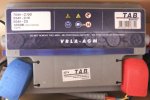UFO
Full Member
- Posts
- 686
- Likes
- 867
I will be installing solar panels on our Adria Twin soon. There is lots advice on this site - so I am almost there.
I think my battery is 70ah (see photo) - so in future bigger battery(ies) will probably be needed, although we have just about managed for 3 years at all times of the year even without LED internal lights, also now installing LED lights.
100W of solar is good for 100ah of battery I understand. I could buy a 120w panel for £155 or 2 x 80w for £147 - so I will go for the 2 x 80w as the installation is only a bit more work and I wil have plent of capacity for future battery upgrade and more charge in the winter months.160W (2 x 80W) Monocrystalline Solar PV Panel 24v 12v Battery Charger | eBay
(a) To avoid running 4 cables (2 each +ve and -ve) from the roof to the charge controller I have been looking for a connection box / harness but can't find anything. Any ideas?
(b) I realise that if I connect the two panals on the roof the cable from the roof to the charge controller will have to be heavier due to 160W. 80w panal specification is
(c) for fixing the panal brackets to the metal roof Sikaflex is recommended. What's the difference between Sikaflex 221 and 252? Which one should I use / does it make any difference?
(d) for preparing the roof Sikaflex cleaner is available. Is this necessary? I would have thought that cleaning with spirit followed by light abrasion would be sufficient.
thank you David
I think my battery is 70ah (see photo) - so in future bigger battery(ies) will probably be needed, although we have just about managed for 3 years at all times of the year even without LED internal lights, also now installing LED lights.
100W of solar is good for 100ah of battery I understand. I could buy a 120w panel for £155 or 2 x 80w for £147 - so I will go for the 2 x 80w as the installation is only a bit more work and I wil have plent of capacity for future battery upgrade and more charge in the winter months.160W (2 x 80W) Monocrystalline Solar PV Panel 24v 12v Battery Charger | eBay
(a) To avoid running 4 cables (2 each +ve and -ve) from the roof to the charge controller I have been looking for a connection box / harness but can't find anything. Any ideas?
(b) I realise that if I connect the two panals on the roof the cable from the roof to the charge controller will have to be heavier due to 160W. 80w panal specification is
- Operatine Voltage: 18.0V
- Operatine Current: 4.44A
- Open-Circuit Voltage: 21.24V
- Short-circuit Current : 4.8A
(c) for fixing the panal brackets to the metal roof Sikaflex is recommended. What's the difference between Sikaflex 221 and 252? Which one should I use / does it make any difference?
(d) for preparing the roof Sikaflex cleaner is available. Is this necessary? I would have thought that cleaning with spirit followed by light abrasion would be sufficient.
thank you David

